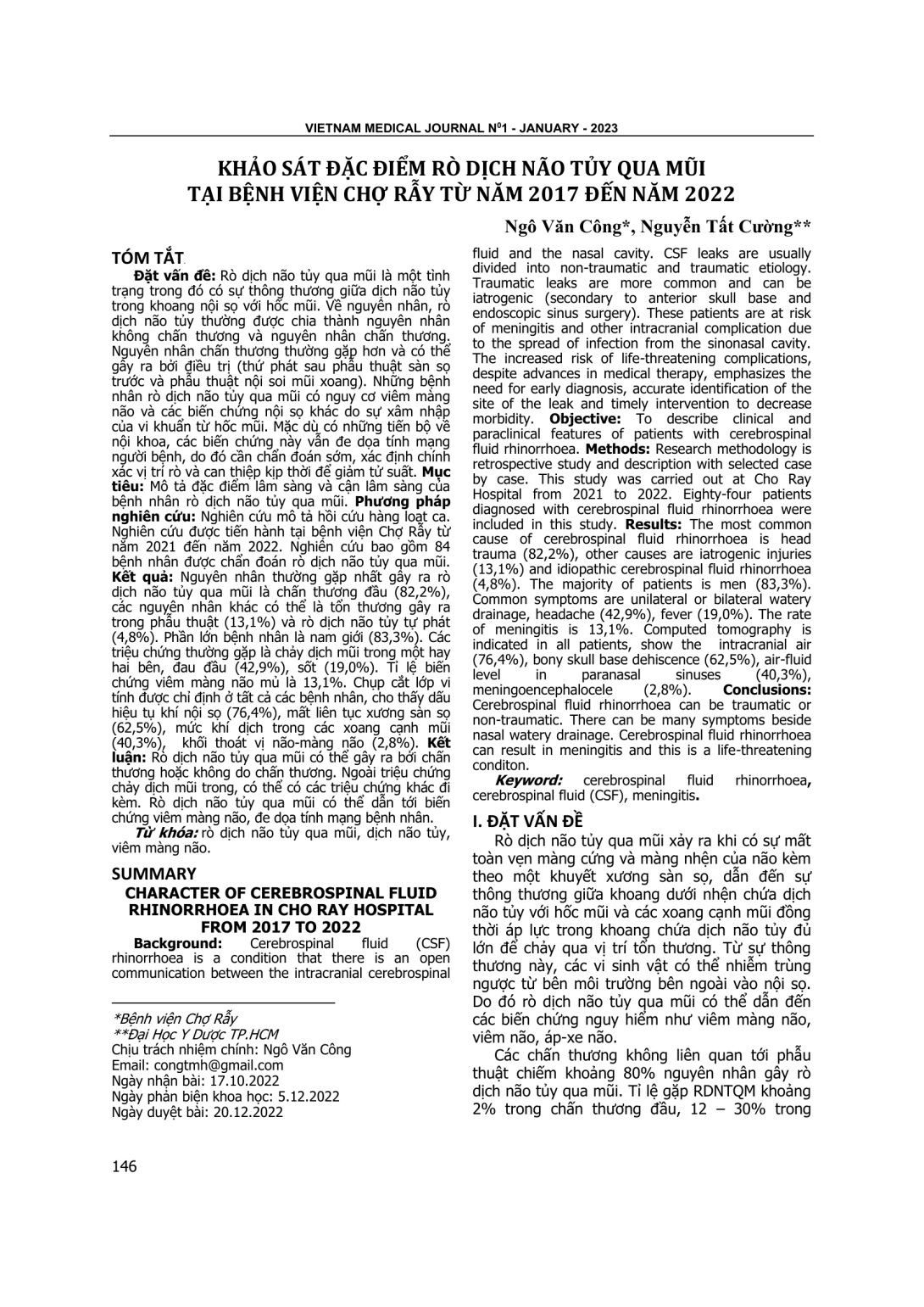
Mô tả đặc điểm lâm sàng và cận lâm sàng của bệnh nhân rò dịch não tủy qua mũi. Phương pháp nghiên cứu: Nghiên cứu mô tả hồi cứu hàng loạt ca. Nghiên cứu được tiến hành tại bệnh viện Chợ Rẫy từ năm 2021 đến năm 2022. Nghiên cứu bao gồm 84 bệnh nhân được chẩn đoán rò dịch não tủy qua mũi. Kết quả: Nguyên nhân thường gặp nhất gây ra rò dịch não tủy qua mũi là chấn thương đầu (82,2%), các nguyên nhân khác có thể là tổn thương gây ra trong phẫu thuật (13,1%) và rò dịch não tủy tự phát (4,8%). Phần lớn bệnh nhân là nam giới (83,3%). Các triệu chứng thường gặp là chảy dịch mũi trong một hay hai bên, đau đầu (42,9%), sốt (19,0%). Tỉ lệ biến chứng viêm màng não mủ là 13,1%. Chụp cắt lớp vi tính được chỉ định ở tất cả các bệnh nhân, cho thấy dấu hiệu tụ khí nội sọ (76,4%), mất liên tục xương sàn sọ (62,5%), mức khí dịch trong các xoang cạnh mũi (40,3%), khối thoát vị não-màng não (2,8%). Kết luận: Rò dịch não tủy qua mũi có thể gây ra bởi chấn thương hoặc không do chấn thương. Ngoài triệu chứng chảy dịch mũi trong, có thể có các triệu chứng khác đi kèm. Rò dịch não tủy qua mũi có thể dẫn tới biến chứng viêm màng não, đe dọa tính mạng bệnh nhân.
Cerebrospinal fluid (CSF) rhinorrhoea is a condition that there is an open communication between the intracranial cerebrospinal fluid and the nasal cavity. CSF leaks are usually divided into non-traumatic and traumatic etiology. Traumatic leaks are more common and can be iatrogenic (secondary to anterior skull base and endoscopic sinus surgery). These patients are at risk of meningitis and other intracranial complication due to the spread of infection from the sinonasal cavity. The increased risk of life-threatening complications, despite advances in medical therapy, emphasizes the need for early diagnosis, accurate identification of the site of the leak and timely intervention to decrease morbidity. Objective: To describe clinical and paraclinical features of patients with cerebrospinal fluid rhinorrhoea. Methods: Research methodology is retrospective study and description with selected case by case. This study was carried out at Cho Ray Hospital from 2021 to 2022. Eighty-four patients diagnosed with cerebrospinal fluid rhinorrhoea were included in this study. Results: The most common cause of cerebrospinal fluid rhinorrhoea is head trauma (82,2%), other causes are iatrogenic injuries (13,1%) and idiopathic cerebrospinal fluid rhinorrhoea (4,8%). The majority of patients is men (83,3%). Common symptoms are unilateral or bilateral watery drainage, headache (42,9%), fever (19,0%). The rate of meningitis is 13,1%. Computed tomography is indicated in all patients, show the intracranial air (76,4%), bony skull base dehiscence (62,5%), air-fluid level in paranasal sinuses (40,3%), meningoencephalocele (2,8%). Conclusions: Cerebrospinal fluid rhinorrhoea can be traumatic or non-traumatic. There can be many symptoms beside nasal watery drainage. Cerebrospinal fluid rhinorrhoea can result in meningitis and this is a life-threatening conditon.
- Đăng nhập để gửi ý kiến
